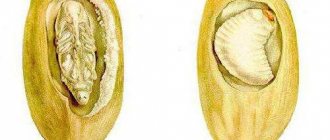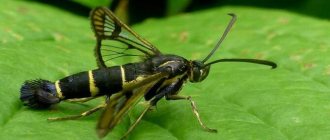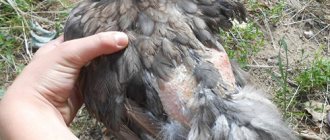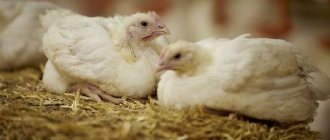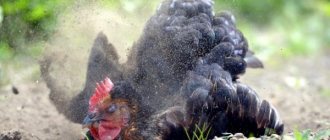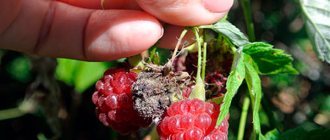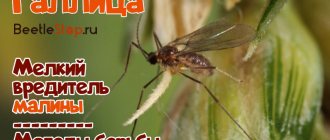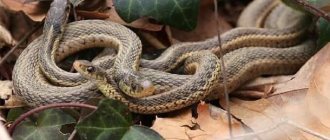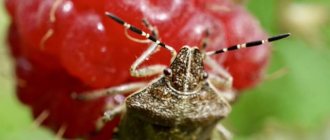Description and characteristics
The raspberry-strawberry weevil is a bug that reaches about 20-30 mm in length, has an oval-shaped body, with an oblong, thin tube head, at the end of which there are cranked antennae.
The insect lays eggs, which rarely exceed 0.5 millimeters in size. They are white in color and round in shape. Larvae hatch from the eggs; they are gray-white in color, 3.5-4 mm long, slightly curved body, without legs. Weevil pupae are 3 mm in size and are initially white, but over time their color changes to brown.
Life cycle of a weevil
Beetles that have not reached sexual maturity hide in the foliage during the winter or are located in the upper layer of the ground. As soon as spring comes and the ambient temperature reaches 14 degrees, the weevils come out into the light and go to the strawberry plantations.
At the beginning of their existence, weevils eat growing leaf blades - they gnaw on them, which leads to the formation of small holes. The number of beetles gradually increases, and the peak of their activity occurs when the plants enter the budding phase.
As soon as the buds appear, insects begin to eat the anthers. To get to them, pests pierce the buds. At this same stage, mating of females and males occurs. Immediately after it, the female gnaws a hole near the bud and lays eggs in it.
The hole is then sealed by the female using her waste products. Afterwards, it gnaws through the peduncle, which after some time begins to dry out and fall to the ground.
Interesting to know
! One female weevil can lay about 50 eggs.
Egg laying usually lasts about one month. Since the budding stage is limited in time, it is impossible for the female to lay all the eggs, so she gradually moves from early to late varieties of strawberries.
The subsequent development of the beetle occurs inside the bud. A week after laying, the larva hatches from the egg. During the first 2-3 weeks of its existence, it feeds inside the bud. After this, the larva pupates and turns into a pupa. The weevil stays in this stage for about 3 weeks, after which a beetle emerges, feeds for another 2 weeks, and then goes off to hibernate again.
What harm does the weevil cause to strawberries?
It’s not for nothing that the beetle was called a weevil - its proboscis can sometimes reach almost half the length of the insect itself. Because of its “activity,” strawberry bushes gradually weaken, shoots fall, and leaf blades dry out and become smaller. The result is complete destruction of the entire crop.
The damage it causes affects not only the buds, but also the core of the plant. You can identify such bushes by looking at them - the leaf blades will be poorly developed and small holes will be visible on them.
Since the female lays eggs in the buds, she needs to make a hole in them too. As soon as the bush is “captured” by the larvae, and the inflorescences and buds are affected, their massive and very rapid fall will begin.
It takes about a month for the larva to fully develop, after which the process will repeat. To identify the pest beetle, you need to visually assess your strawberry plantation:
- the buds will be broken at the base;
- almost all flower stalks have fallen off;
- leaves have small holes.
In just one season as an adult, one insect can destroy about 60-70 flower stalks. And if a whole colony of weevils lives in the garden, then you can immediately forget about your harvest (of course, if you do nothing).
If you didn’t have time to do anything, and the insect still ruined the plantation, then it can easily move to the raspberry bushes. And there it will continue its life activity according to the same pattern.
Therefore, you must carry out a series of all necessary preventive measures in a timely manner so that the pest weevil cannot live in the uncomfortable conditions created artificially for it.
Varieties
The most common types of bevels are:
- Raspberry-strawberry. The elephant has an oval shape, the color of the body and proboscis is black. Covered with dense light gray bristles. Grows in length up to 3 mm. He prefers to settle in the European part of the country, as well as in Altai and Siberia. It feeds on blackberries, raspberries, strawberries, rose hips, strawberries and other berries. Leads an active life from May to June. Overwinters in the soil.
Raspberry-strawberry weevil
- Small black. The body of this individual looks like an elongated oval. The trunk is short and wide at the end. Color – black or brown, but with a shiny tint. The body is decorated with chiseled grooves and sparse gray stubble. The length of the elephant is 5 mm. He lives only in the European part. The diet consists of berries, beets, alfalfa and conifers. The beetle is active only in the dark.
- Burdock or rough. The body has the shape of an oval, its color is light brown. There are also sparse whitish bristles. The insect is called rough because of the presence of yellow scales and raised tubercles on its body. The proboscis of this beetle is not long; on the contrary, it is short and widens towards the base. The length of the insect is 7 mm. It is widespread everywhere. Prefers to eat buds, tops of berries or vegetables. The larvae eat mainly roots. Most active during cloudy weather. He has good acting skills: if you touch him, he will pretend to be dead.
Burdock elephant
- Furrowed. The elephant is colored brown or gray-black with yellow streaks. There are dotted grooves on the body. The proboscis is short and wide. Length – 10 mm. Prefers to live in “warm” places: in a greenhouse, greenhouse or nursery. It can feed not only on berries, but also on industrial crops. Does not disdain decorative flowers. The beetle has a special love for the grapevine. Adult insects eat buds, leaves and fruits, while the larvae destroy the roots.
- Alfalfa. The largest beetle on this list. Its length can be up to 12 mm. The body color is black or brown. It is completely covered with gray scales and yellow bristles. You can find it in the Caucasus, in the European part of Russia or in Southern Siberia. In addition to berries, it actively nibbles on legumes, vegetables, and hops. Active - from May to July in the morning or evening.
How to get rid of weevils using folk remedies
Folk remedies have become in great demand in the fight against weevil. Traditional methods have been tested for years and are safe for health. Let's look at some methods of fighting weevils using folk remedies.
Treatment with mustard solution
One hundred grams of dry mustard is first diluted in a liter of water, then another two liters are added. The prepared solution is sprayed onto strawberries.
Garlic tincture
100 gr. Add dried garlic leaves to a bucket of water and leave for 24 hours. Treat plants with the prepared solution at the rate of one liter per square meter.
Wood ash
Wood ash is poured in a thick layer under each strawberry bush. Wood ash is an excellent insect repellent.
Infusion of onion peel and celandine
Pour two parts of onion peel and one part of celandine with hot water for a day. Then strain the solution and spray the strawberries.
Soap solution
To prepare the solution, you need to grate 100 grams. laundry soap. Add soap to a bucket of hot water and stir. Allow the solution to cool, then begin processing.
Flaws
The disadvantages of folk remedies are that they require more time and effort. Valid until it starts raining. The rain washes away all your hard work.
Chemicals
Chemicals are the most effective means of controlling insects. The most common are:
- spark
- karbofos
- intavir
- Fufanon
- fitoverm
- alatar
- bitoxibacillin
Insect control products must be diluted strictly according to the instructions. Otherwise, you may ruin the strawberries.
Disadvantages of chemicals
Chemicals tend to settle in plant tissues, which is harmful to humans. In addition, chemistry, in addition to insect pests, destroys bees and ground beetles, which bring great benefits to your garden. But unfortunately, if other methods do not help destroy the weevil, you will have to use chemicals.
Other methods
In the fight against weevils, all methods are good, except for chemical and folk remedies; insects are collected manually or traps are set. You can make traps yourself; for this you will need: 500 ml. water, 50 gr. yeast and 100 gr. Sahara. Combine everything and mix well, leave in a warm place for fermentation. Then pour into glass bottles with a narrow neck. Once caught in such traps, the weevil will not be able to crawl out.
Mechanical methods
Dry leaves and debris are removed from strawberry beds. The soil around the strawberries is loosened.
In spring, the beds are watered with hot water. Damaged ovaries and buds are removed and burned.
Control measures
Mechanical methods
Other mechanical pest control measures include:
- manual collection and destruction of beetles;
- collection of fallen buds and subsequent destruction - they may contain larvae;
- autumn digging of soil under bushes;
- collecting fallen leaves after harvest.
An effective way to control weevils is with traps. You can prepare them yourself using available ingredients. For 500 ml of water, take 50 g of yeast and 100 g of sugar, leave the mixture in a warm room until the first signs of fermentation appear. Next, the solution is poured into containers with a narrow neck - once the beetles fall into the trap, they will no longer be able to get out of it.
Chemical methods
Strawberries can be treated against weevils in spring and summer with the following preparations:
- Karbafos, Metafos are simple and affordable options, but they act for a short time and destroy insects only when they come into direct contact with them;
- Inta-Vir is a broad-spectrum drug that poisons beetles and blocks their nervous system;
- Nemabakt (analogs - Fitoverm, Akarin) is a biological protection agent containing a nematode that destroys insects, and is applied routinely to the soil at any time of the warm season.
If strawberry weevils appear during the flowering period of plants, it is better to collect them by hand. Using insecticides can harm the bees that pollinate flowers.
Traditional methods
They can be prepared from simple ingredients that can always be found on the farm.
- The simplest method is to plant beds of garlic and onions around the berry bushes. The smell of these plants will repel weevils.
- Wood ash is not only a valuable fertilizer, but also a popular insecticide. It can be scattered around bushes or beds, and also diluted in water for irrigation.
- An infusion of tansy and calendula also repels pests. It is sprayed on the leaves and buds of plants, and also applied to the soil. Fern grass has a similar effect, so it can be placed around the bushes.
- Garlic infusion is one of the most popular ways to combat pest beetles. 100 g of garlic pulp is infused in 10 liters of water for a week. Then the plants are sprayed with it. You can add 2 tablespoons of boric acid to the mixture.
- Regular potassium permanganate is also used in the garden. It is enough to dilute 5 g of dry raw materials in a full bucket of water. Distribute over the soil surface, leaves and buds. Instead of potassium permanganate, you can take 300 g of ground hot pepper.
The strawberry weevil is common in temperate climates. If it appears on the site, it will quickly continue to multiply, destroying cultivated plants. If you intervene in time, you can forget about the beetles and get a high-quality harvest.
House weevil
The weevil in the house is the same granary weevil in the grain, and it gets into the apartment along with the cereal brought from the store. An adult female gnaws a hole in a grain and lays only one egg in it, after which she seals the hole with her own secretions. After 6–12 days, a larva emerges; it eats away the inside of the grain, after which it gnaws through the shell and climbs out. The fight against the weevil is complicated by the fact that the larva located inside the grain is quite difficult to detect. However, various ways to combat such a pest have been invented.
Repellent plants
Flowers and herbs should be planted around the perimeter of the strawberry plantation. This way they will protect a large area from the pest. It is allowed to place plants between berry bushes.
Onions and garlic help well in the fight against insects. You need to plant 1 clove for every 4 bushes. Cut off the leaves and arrows more often so that the smell remains strong.
Marigolds will help avoid damage to flowering buds. Sow the seeds among the strawberry bushes. You can place calendula and other plants with a strong smell next to the berry. Basil, parsnips, celery, and amaranth will help repel pests.
Parsley, dill, and petunia are considered insecticidal plants. Plant these crops along the perimeter of the plantation or every 3 rows of bushes. Plants will prevent pest eggs and caterpillars from appearing on the leaves.
Pests of remontant raspberries in spring: description with photographs
Raspberry pests in spring cause the greatest damage to the future harvest. Pests of remontant raspberries are especially dangerous, as they continue to damage buds, flowers and ovaries throughout the season. Next, we propose to consider the most common types of these insects.
Raspberry-strawberry weevil
The raspberry-strawberry weevil, or raspberry flower beetle Anthonomus rubi Hrbst., is a beetle 2.5-3 mm long, black, sometimes with a brown tint, covered with thick light gray hairs. The proboscis is thin, slightly curved, the antennae are club-shaped. The larvae are grayish-white, curved, legless, with sparse hairs.
The weevil damages raspberries, strawberries, roses, as well as herbaceous plants from the Rosaceae family. Beetles overwinter under fallen leaves under raspberry and strawberry bushes. In the spring they come to the surface and feed on leaves, eating deep holes and small through holes in them. After additional feeding, the females lay eggs in the buds and gnaw the peduncle, causing the bud to break and fall off or remain hanging.
The larva develops inside the bud and pupates there. Young beetles emerge in the middle of summer and feed on young leaves until autumn, gnawing small holes in them. In the fall, the beetles go to winter. With a large number of weevils, the yield of berry crops, especially strawberries and raspberries, sharply decreases. The pest is widespread.
Control measures. Spring spraying of berry bushes when buds open and two weeks before flowering with fufanon or its analogues (kemifos, karbofos). When there is a large number of beetles in the summer, individual berry crops are sprayed with the same preparations. You can also use the drugs Kinmiks, Actellik, Iskra, Inta-Vir, taking into account the waiting period.
Fruit mower
Fruit mower Otiorrhynchus aurosparsus Germ. - weevil 7-9 mm long. The entire body above and below is covered with small round light golden scales and short hairs. The larvae are thick, legless, white, curved, with a yellowish head, and feed on the roots of herbaceous plants. The pupae are yellowish, open-type, with noticeable legs, wings and proboscis. In the spring, beetles gnaw out leaf buds and later flower buds of raspberries. The mower is polyphagous and causes great damage to berry bushes: raspberries, currants, gooseberries, as well as cherries and apricots.
Control measures. Preventive spraying in the spring, when buds open, with one of the drugs: fufanon, kemifos, actellik.
Study carefully these raspberry pests according to the descriptions with photographs, which are presented in large quantities further on the page!
Morphology
Imago. Beetle 2–3 mm long. The body shape is oval, widening beyond the middle. Like all representatives of the genus Anthonomus, the head has moderately convex eyes, but protruding beyond its contours; antennal flagellum seven-segmented; pronotum transverse; the elytra widen behind the middle, with well-developed humeral tubercles located at the base; hips with a simple tooth. The color of the integument of the raspberry-strawberry weevil is black, occasionally with a brown tint, the body is densely covered with gray hairs. The rostrum is long, thin, slightly curved. The shield is white. The legs are long and thin. The shins are thin, straight on the inside. The punctures on the pronotum are very dense and small. The antennae are geniculate and club-shaped.
The egg is round, yellowish-white in color. Size – 0.35–0.5 mm.
The larva is sickle-shaped, white, with a brown head. It reaches 5 mm in length. Legless, with sparse hairs.
The pupa is yellowish-brown in color. Size – 2.5–3 mm. At the beginning of development it is white.
Phenology of development (in days)
Destruction of weevils using folk remedies
The use of folk remedies against parasitism of harmful insects is considered the safest method. Time-tested drugs are effective and reliable.
To destroy pests you can use:
- Mechanical method. It is convenient to collect beetles in the early morning when they are in a state of torpor. You need to spread sheets of paper or newspaper under the strawberry or raspberry bushes, shake the leaves and branches of the plants. Beetles that parasitize shrubs will fall onto the paper. Then all that remains is to wrap them up and destroy them.
- Trap. Prepare sweet insect bait based on 500 ml. water, 100 gr. sugar and 50 gr. raw yeast. Mix the prepared ingredients thoroughly and leave the mixture to ferment for several hours. After this, pour the resulting sweet solution into a glass or plastic bottle with a narrow neck. Bugs that have climbed into a bait trap cannot crawl out of it. Bottles containing bugs should be destroyed.
- Treatment with mustard solution. Prepare the active composition from 100 g. mustard powder and 3 l. water. Mix the mixture thoroughly and process the raspberry and strawberry bushes.
- Herbal decoctions. Prepare a decoction based on “fragrant” herbs. As an active herbal remedy, you can use wormwood, garlic, tansy, and hot pepper. The prepared decoction should be sprayed on plants affected by the weevil.
- Adhesive solution. Prepare a mixture based on 40 g. grated laundry soap, 1 kg. wood ash and a small amount of water. After mixing all the ingredients, you should get a sticky mass, which is used to spray insect-infested plants.
- Treatment of plants with wood ash. In early spring, next to strawberry or raspberry bushes, sprinkle a thick layer of wood ash on the soil. The specific smell will repel the pest and save the plant fruits from death.
Treatment of affected plants with folk remedies is carried out as necessary. To consolidate the result, it is necessary to carry out about 3-4 sprayings.
As a preventative measure, treatment is carried out three times: the first time a week before the buds begin to bloom, the second time in mid-summer, and the last time after harvesting.
What do people advise?
There are always simple and affordable means at hand that can be used against the pest.
- Wormwood solution. Cut a kilogram of fresh stems, add water (5 liters) and boil over low heat for a quarter of an hour. The remaining broth is brought to 10 liters with water. Boil for another 5 minutes. Dissolve 50 g of soap (tar, laundry, green) in a warm composition. Leave for a day in a dark place. The bush and the ground underneath it are being cultivated.
- Walnut. Pour 300 g of leaves into 1.5 liters of water. Boil. Leave for 24 hours.
- Mustard or laundry soap. One or another component is taken in the amount of 200 g at the rate of 10 liters of water. A week before flowering, the bush is sprayed. After a week and a half, repeat the treatment.
- Hot pepper. Chop 0.5 kg of fresh pods. In an enamel bowl, fill the raw material with water (5 l). Leave for 2 days to infuse in a sealed container. Boil. Leave for another 48 hours to infuse. Strain well, squeezing out the sediment. Fresh fruits can be replaced with dry ones. Then you will need 250 g of raw materials. Proportions must be observed. Otherwise, the burning solution can simply burn tender young shoots and buds. Treatment is carried out twice or even 3 times. Be sure to spray before budding and at the beginning of the formation of inflorescences.
- Common tansy. Half a kilo of fresh stems and flowers, as well as 2.5 liters of water. Mix everything and leave for a day. Boil, strain and squeeze.
Tansy tincture is effective against many pests
- Hellebore. The poisonous plant is boiled. To do this, you need to grind 1 kg of it, add water, and let it brew for a couple of hours. Boil and cook for half an hour. The strained composition is brought to a volume of 10 liters with plain water. Plants are irrigated with this product immediately after harvesting the fruits. At this time, young beetles hatch. Because The decoction contains toxic substances and should not be used during the formation and ripening of fruits.
- Garlic. An infusion is prepared from a glass of chopped garlic and water (bucket). It infuses for 24 hours. Strained. The bushes are sprayed with a liquid suspension after sunset.
- Onion waste and celandine. Take 1 part of the plant for 2 parts of the husk. The raw materials are placed in a container with a volume of 3 liters. It is filled one third with boiling water. After waiting until it cools completely, the contents are filtered. The berry garden must first be treated after the first flowers appear, and again after 14 days.
- Onion husks. It fills the container halfway. Top up with water. Leave for 24 hours. Strained. The concentrate is diluted half with water. It must be processed once every 5 days.
- You can fight weevils on raspberries using traps. The bait (yeast solution) is placed in them. It is prepared in the following proportions: water (500 g), sugar (100 g), yeast (50 g). The composition is left to ferment in a warm place. Lubricate the inside of the walls of polyethylene or glass bottles with sunflower oil. Pour the solution in a thin stream, filling the container to ¼ volume. The beetles will crawl into the bottle through the neck based on the smell, and they will not be able to get back out of it along the slippery walls. The contents of the container are changed every 3 days. Traps do not need to be removed for the entire flowering period of crops.
When deciding how to treat raspberries against weevils, you need to focus, first of all, on repellent methods, prevention and compositions from herbs and plants. Use chemicals only in cases of extreme necessity.
How to fight
Comprehensive methods of combating weevils include the following measures:
- Agrotechnical – loosening and plowing of the soil, isolation of infected crops, crop rotation, destruction of plant residues.
- Biological - involve the use of natural insecticides or the attraction of natural enemies of the pest beetle (birds, ants, wasps) to the site.
- Chemical – use of inorganic products, treatment of seed, soil, etc.
- Mechanical - collecting or shaking off beetles.
Their use depends on the characteristics of the species attacking the area.
What to treat in the spring?
- Infusions of tobacco, garlic (200 g per 10 l of water) or hot pepper (500 g per 10 l). These products are used during the formation of buds.
- Infusion of celandine and onion peel (1:2). Fill a three-liter container with the mixture and fill one third with boiling water. Strawberries are sprayed at the stage of flowering and ovary formation.
- Decoctions of tansy, wormwood and mustard infusion with the addition of laundry soap (40 - 50 g of soap per 10 liters of liquid). It is used during the formation of buds.
- Solutions of boric acid, potassium permanganate, ammonia.
The effect is enhanced by mulching the beds with ash and dry pine needles. In spring, it is recommended to treat the soil with an iodine solution (half a teaspoon per bucket of water). You can also spray the bushes with a solution of mustard powder, learn more from the video below:
How to get rid of biological products and chemicals
Chemical methods are rarely used, but sometimes you cannot do without them. So for large-scale quarantine measures they use:
- gas "Metabrom-RFO",
- drug "Foscom" in tablets.
For local lesions, contact insecticides that are quite safe for humans are often used:
However, such drugs kill not only weevils, but also beneficial pollinating insects and affect earthworms and birds.
Biopesticides are preferable because they act more specifically and provide excellent long-term protection. These drugs contain microorganisms that attack pests. For example:
- "Iskra Bio" based on avermectins, which cause paralysis in elephant beetles,
- "Nemabakt", containing a predatory nematode capable of destroying mower larvae in the ground.
Biopesticides are absorbed by the plant without causing harm to it or the environment.
Who gnawed the cucumber sprouts?
The larva of the sprout fly manifests itself on cucumbers, peas and some other vegetables: their seedlings die because their roots are gnawed. It must be said that usually single shoots are lost, which can be ignored, but sometimes the entire crop is lost (for example, in a greenhouse where only cucumbers are grown from year to year).
Since the larva attacks only barely germinated plants, in which the cotyledons have not yet fully emerged to the surface, we must strive to ensure that the seedlings overcome this young state as quickly as possible. That is, the seedlings must grow extremely quickly so that a real leaf appears and the roots branch out as quickly as possible - from now on the sprout fly larva is no longer scary.
To do this, it is necessary, firstly, to add humus and compost to the top layer of soil in advance, and secondly, to get to a warm time (do not plant before the spring cold has passed). All this accelerates seed germination. If in your area there is often a dominance of flies, sow not in early May, but in early June - at this time the seedlings grow very quickly.
A transparent film placed directly on the ground helps very well; it further accelerates the development of seedlings. As soon as the cotyledons appear, the film is removed. After using this simple approach, your germ fly problem will disappear.
Raspberry beetle and raspberry weevil
On raspberry flowers you will always find two types of bugs: one black one with a proboscis - this is the raspberry weevil, or elephant weevil; the second is light brown, looking like a tiny cockchafer. Both of them damage the flowers, which is why the berries then become crooked or disappear altogether. When in danger, the bugs curl up their paws and fall down. These “beasts” are capable of destroying the entire raspberry crop. Sometimes there are so many of them on the bushes that even shaking them daily into a tray does not save the berries at all.
It is believed that beetles are driven away by infusions of elderberry, wormwood, etc. Frankly speaking, they are rather weak! The truth is that if the beetle was allowed to calmly get out of the soil in the spring, then it cannot be stopped so easily. The beetle must be dealt with while it is in the soil. Therefore, it is useful to first till the soil in the raspberry patch twice - in the fall and early in the spring, and then cover it with a thick layer of mulch. The beetle will, firstly, have its passages through which it intended to crawl out destroyed, and secondly, a dense layer will block its path. Film mulch is the most reliable.
When you come across a productive raspberry tree whose owners report that they don’t spray it with anything at all, then, of course, you begin to look for the reason for the suppression of beetles. It can be very different. Often such support is provided by a constant thick layer of mulch: our gardeners once remembered that “raspberries love garbage,” and some lay manure, some hay, some sawdust under the bushes for fertilizer.
And the main benefit of mulch is that it somehow disrupts the conditions for successful wintering of this pest. Apparently, the beetle survives well in dense clay soil, and loose mulch contains many insect predators that destroy it.
One day I came across an unforgettable raspberry garden: rows of bushes strewn with large, clean berries. The owners lived in it with a couple of chickens: they walked along the rows all day long, stirring up the garbage under the bushes with their claws, looking for food. Either the birds “trampled” the passages of the beetles, or pecked them off, but they apparently affected the safety of the crop.
Sometimes raspberries growing mixed with fruit trees have their advantages: due to the shade, many berries set late, when the wave of beetles has already subsided. It is the late berries that are often the purest.
Of course, mixed planting of raspberries with other plants can be beneficial. This issue has so far been little studied. According to my observations, raspberries growing mixed with red currant bushes produce annual harvests of berries; even if the beetle is present, for some reason it cannot unfold. At the same time, red currants bear fruit abundantly.
Where do worms in berries come from?
Garden pests usually become active in the spring, after overwintering in the soil
The habitat of insects or their larvae (pupae) can also be compost, weeds, fallen leaves and any other organic matter on the site, which is why it is very important to remove all plant residues after harvesting and not use them as shelter for raspberries
However, parasites can also be carried by wind, birds, and even other insects. For example, aphids are carefully spread to trees and shrubs in the spring by ants that feed on the honeydew secreted by this garden pest, and they often provide winter shelter for aphids in their anthill.
Did you know? The well-known thieves' term "raspberry", which in slang means a gang gathering place, a hangout, from an etymological point of view has nothing to do with the sweet berry. In old Odessa, this word originally sounded like “melina”, which translated from Hebrew means “shelter”, but was later somewhat distorted.
Thus, it is impossible to completely protect your site from the invasion of pests, including those that lay eggs in the ovaries and thus cause worms in the fruit. At the same time, a good gardener is still able to create conditions that will reduce the likelihood of such a problem occurring.
So, the main mistakes that need to be avoided in the process of planting raspberries and caring for them come down to the following:
you cannot plant raspberries next to blackberries, including wild ones, as well as meadowsweet, since these plants have common enemies; The appearance of a large number of ants on the site should not be ignored; in addition, it is important to promptly and actively combat aphids, which are carried to crop plants by these “hardworking” insects; humus and compost are a frequent source of infection of beds and gardens with pests, so such fertilizers should be applied in doses and, if possible, combined with soil treatment with modern biological products to kill pests; pests feel much more comfortable in areas with dense plantings, so overly active growth of shrubs must be dealt with in a timely manner; Ignoring such activities as regular weeding is another common reason for an area to become infected with harmful insects and mites
Pests living on raspberry bushes
Strawberry-raspberry weevil
This is a small insect, black with a gray tint. It is voracious: it damages young leaves and flowers. The female lays eggs in the buds. When the beetle larvae emerge, they feed on flower particles and turn into pupae.
To detect the presence of weevils, you can tear off a damaged bud, which will reveal a white larva with a yellow head. Starting from mid-July, insects form from them. The weevil overwinters in fallen leaves and at shallow depths.
Fighting methods:
- Before flowering, the raspberry bush is treated with Confidor or Iskra.
- After harvesting, spray with Karbofos a second time.
Raspberry mosquito (shoot galitz)
The main damage to raspberries is caused by gall midge larvae. The mosquito emerges in April-May, when the growing season of berry bushes begins and the ground warms up to a temperature of +12 °C. The female lays eggs near the base of the shoots. After this you can see many orange larvae. When an insect invades, cracking spots appear on the stems. When the larvae move, they form eaten grooves. As a result, the bark dies and the shoots dry out.
After the end of the feeding period, the larvae enter the top layer of soil. There they form web cocoons. If an area with raspberry bushes is heavily infested with shoot galitsa, then up to 80% of all berries may be missing.
Fighting methods:
- Spray the berry crop and the ground around it with 0.2% Karbofos emulsion in the spring before the raspberry mosquito appears. At this time, young branches of bushes begin to grow.
- The second time the treatment is carried out 10–12 days after the first.
- If digging is carried out with a layer turnover to a depth of 10 cm in the fall or spring, this will help get rid of some of the larvae during wintering.
- All damaged raspberry branches should be cut out and burned.
Raspberry beetle
The raspberry beetle has an elongated oval body, yellow with a gray tint, and its length is up to 3 mm. The larva is white, with a brown head. Both adults and their larvae are dangerous.
After winter, the beetles emerge from the soil, where they were sitting at a depth of up to 10 cm, and begin to live on weeds and flowers of fruit trees. Then they move to the raspberry bushes. First, adult beetles feast on young leaves between the veins, then they damage the pistils and stamens in the flowers of berry bushes. Pests lay eggs in flowers.
Their larvae harm raspberry fruits: they eat up the drupes and make holes in the stalk. Wormy berries lose their marketable appearance and become unsuitable for consumption, both fresh and for jam. Having completed the development cycle, the larvae return to the ground after 40 days to pupate.
- Sprinkle raspberries during budding, before flowering, with Karbofos or Confidor, Decis, Iskra.
- While the pupae are in the soil, it is recommended to dig up the soil near the bushes and between the rows to a depth of 15 cm.
Raspberry shoot and leaf aphids
The first type of aphid settles on berry crops in colonies, preferring their young parts, and the second, in small groups, is present on the back side of raspberry leaf blades and feeds on the sap of the plant.
The method of combating this pest is to treat the bushes with Actellik or Karbofos. The procedure must be carried out during the bud break of the plant.
Raspberry bud moth
The larva grows up to 9 mm. During the beginning of the growing season, when the buds swell, these pests eat them. After eating the buds, the larva enters the inner part of the stem. When these insects multiply en masse, up to 90% of raspberry buds can be damaged. Old plantings are often riddled with this pest.
Fighting methods:
- Those shoots from which the harvest has already been harvested are broken out and burned. This is done in the fall or spring (before the caterpillars appear after winter).
- Treated with Karbofos during kidney swelling. Instead of this product, you can take solutions of the drugs Confidor, Decis, Iskra.
White spot (septoria)
Fungal septoria occurs due to marsupial fungi - Septoria rubi. The fungus spreads along shoots, foliage and stems.
Fungi actively reproduce at high air humidity. Also, if the plantings are thickened, there is an excess of moisture in the soil, with sudden changes in weather.
The disease can be detected at the end of June. Dark brown spots appear on the leaves.
Later in autumn, the brownish spots become lighter, and black dots appear in the center. At these points there are spores. The spots spread across the leaf and it dries out.
Blurred spots of various shapes are visible on the petioles; they are reddish-purple. Almost every shoot is also spotted. The spots grow within 14 days.
Prevention and treatment
For prevention, weeds are constantly pulled out, diseased stems are cut out and burned. Thin out plantings.
For treatment in early spring, when the buds have not yet swelled, raspberries are treated with Nitrophen, dissolving 200 g in a bucket of clean water (10 l).
Before the buds open, they are sprayed with Zineb 2 times: 1 time, pour 50 g of the drug into a bucket of water (10 l) and spray, and after 10 days they are also treated with Zineb solution, placing 30 g in a bucket of water. After picking the berries, the bushes are sprayed with Bordeaux mixture.
How to treat strawberries against weevils?
The fight against beetles should be carried out long before the buds appear. Weevils cannot tolerate cold air; during this period they simply hibernate. Therefore, it is advisable to start processing when there is still snow in the yard.
An inexperienced gardener may get lost in the variety of modern pest control products. In addition, familiar gardeners can give a lot of advice based on their experience. How to make the right choice, not throw money away and save your harvest?
To do this, you can use the services of sanitary services. They will be the ones who will be able to correctly assess the problem and choose the appropriate method of getting rid of the beetles.
Chemicals
Many people resort to using chemicals. This spraying should be carried out in spring and summer.
It is very important to choose the right moment here.
This method of fighting is the most effective. The result can be secured by using fertilizer that is enriched with microorganisms. They prevent the appearance of not only weevils, but also other harmful insects. This will help not only save the fruits, but also make them more juicy.
Folk remedies
Many owners are wary of various types of chemicals. They prefer to use grandmother's proven methods. And there are a huge number of them.
Folk remedies against weevils:
- Plant onions and garlic around the strawberry bushes or next to them. The weevil does not like their smell and will not be able to get close to your plantings.
- So, for example, in the evening you can spread sheets of newspaper on the soil. Shake your strawberry bushes in the morning to knock out the bugs. Then burn the collected parasites.
- Prepare an infusion of wormwood, tansy or hot pepper and spray your plantings with it. The same sprays help against slugs in the garden.
- Another cheap way is mustard solution. For spraying, only 100 grams of powder and 3 liters of water are enough.
- Place a piece of fabric on the bed around the strawberry bushes. Next, lay corrugated cardboard on top of the leaves. During the solstice, dangerous pests will hide in the shade under cardboard. After half a day, simply roll up the cloth with the beetles and burn them.
- A solution of potassium permanganate effectively fights weevils: dilute 5 grams of the product in ten liters of water.
- Even tooth powder is effective. It can be purchased inexpensively at any pharmacy. Sprinkle it on your strawberries when rosettes begin to form or after flowering has passed.
- Make birdhouses in your yard. Birds love to eat weevils.
- Prepare a mixture of pine wood (400 ml), garlic (100 g), boric acid (2 tbsp) and a bucket of water. This composition should sit for a week, after which you can safely begin to irrigate the leaves.
- Prepare the yeast substrate. To do this you need 0.5 liters of water and yeast (50 g). In order for the solution to begin to ferment well, 100 g of granulated sugar can be added. When you feel a specific smell appear, pour it into bottles (glass or plastic. Two-thirds of the container should remain empty. Hang the bait near the strawberry bushes. Some lubricate the bottle with sunflower oil. The weevils will crawl into the container with the bait and will not be able to get out. Remember to clean the bottles and refresh the contents from time to time.
- Treat the plantings with a decoction of bitter wormwood. Pick the whole plant and wilt it a little. Boil the mixture in five liters of water for about fifteen minutes. Strain the solution and add cold water. The result should be about ten liters of liquid. You can improve the effectiveness of the prepared solution by adding 40 g of crushed soap
- Iodine. Irrigate the soil using iodine solution. To do this, dilute a teaspoon of iodine in a bucket of water.
- Ammonia. Treating the leaves with ammonia helps a lot. So, you can grow a good harvest.
- Wood ash. It would seem that such a simple but effective method will easily help get rid of the parasite. To do this, you only need forty grams of ordinary laundry soap and three kilograms of wood ash. The end result should be a sticky mixture. You can also simply scatter ash near the strawberry leaves in the spring.
Do not forget that after rain their effect loses its effect. Therefore, you will have to repeat the procedure often
But the most important thing is timeliness. By taking care of the fight against weevils in advance, you can preserve your harvest and get tasty fruits
Prevention
Prevention of the spread of gall midges in raspberry fields includes the following measures:
- Careful selection of exclusively healthy seedlings for planting. Damaged planting material is discarded.
- Selecting a raspberry variety that is resistant to the pest. For example, Creed, Phenomenon, Faith. The gall midge avoids these varieties. Another option is to choose only remontant varieties for planting. Complete autumn removal of shoots will help prevent the development of stem gall midges in the raspberry forest.
- Avoid thickening the raspberry plantings. To do this, they carry out sanitary pruning in a timely manner and practice growing raspberries on trellises. The sun's rays should penetrate deep into the bush.
- Fragrant plants are planted around the raspberry plantation. The insect cannot tolerate the aromas of onions, parsley, dill, and garlic. Repellent plants need to be planted in such a way that they grow next to the raspberry tree all season. But it should be taken into account that this measure is effective only in combination with others, and parsley alone in a raspberry garden will not save you.
- Raspberries should not be filled with water in large quantities. High humidity levels stimulate the development of larvae and attract gall midges. For the same reason, bushes are not planted in lowlands where moisture accumulates.
- To get rid of the insect and prevent it from overwintering quietly, the soil around the raspberries must be loosened, especially before winter, or dug up shallowly.
- It is advisable to use pine sawdust as mulch. Soil covered with mulch material will be inaccessible for wintering for most pests. The resinous smell of pine needles will repel insects.
The appearance of Galitsa on raspberries almost always indicates incorrect agricultural practices and neglect of the garden. If you follow all the recommendations listed, the appearance of gall midges on the plantation can be reduced to zero.
How to deal with weevils in an apartment
How to get rid of barn weevil after finding it in an apartment? There are simple and effective ways to combat the pest, based on the characteristics of its life and reproduction:
- check all stored cereals, tea, cocoa, coffee, pasta and flour in which weevils can settle and, if you find traces of their presence, get rid of these products, since the secretions of weevils and their larvae are carcinogenic;
- since weevils and their larvae die already at -5 ºC, you can place not yet infected products, in which pests can settle, in the freezer for 2-3 days. For preventive purposes, you can do this with all the cereals, flour and pasta that you buy;
- Weevils also die when heated to 40 ºC for two days, and if the heating is increased to 60 ºC, then in six hours, so it makes sense to heat the cereal in the oven;
- It is better to store already disinfected products in glass or plastic, hermetically sealed containers that will be difficult for the beetle to chew through. Place whole, peeled cloves of garlic into jars with cereals and pasta, you can put 2-3 nutmegs in the flour, and sprinkle a little hot pepper into the peas and beans;
- shelves and surfaces on which there are containers with cereals, flour or pasta are treated from time to time, first with a soap solution, and then with water and table vinegar, and after treatment, cloves, bay leaves or lavender flowers are laid out on them;
- To make it easier to monitor the condition of the products, do not stock too much unnecessarily.
How to treat strawberries against pests
When processing, you should use preparations that are low-hazard for bees. At the end of April - beginning of May, the flowering period begins not only for strawberries, but also for many plants. At this time, the mass emergence of bees and other pollinating insects begins. By destroying pests, great harm can be done to beneficial insects.
The following drugs are considered low-risk:
The treatment must be carried out in dry, windless weather. If it rains immediately after treatment, the drug will be washed off the plant. Spraying will have to be repeated
When choosing an insecticide, you should pay attention to what air temperature it is most effective at. Some drugs have the desired effect only at certain temperatures.
Insecticide treatment is not carried out on blooming flowers.
Protective and preventive measures against beetles
To save plantings of strawberries, raspberries and other berry crops from the voracious beetle, care should be taken to create conditions on the site that are unfavorable for its existence. Experienced gardeners recommend taking the following precautions:
- regularly dig up the rows to destroy beetles hiding for the winter;
- avoid dense, unkempt areas;
- renew raspberry and strawberry plantings by removing old plantings;
- periodically inspect the plantings and shake off crawling raspberry weevils until the end of the harvest;
- if possible, plant early varieties of strawberries and strawberries;
- the raspberry weevil does not tolerate the pungent odors of Chernobrivtsev, lilies of the valley, nasturtiums and garlic, so they can be planted next to the berry garden;
- remove and burn all garden waste in spring and autumn;
- destroy damaged shoots and leaves;
- try to attract the natural enemies of the weevil, ground beetles, into the garden, which are capable of destroying up to twenty-five beetles each per day.
These and other preventive control measures will reduce the risk of garden plot infestation with dangerous agricultural raspberry pests.
Signs of a harmful beetle in the garden
The main symptoms indicating the presence of weevils on berry crops include the following characteristic phenomena:
- small diameter holes or punctures on early strawberry foliage;
- browned berry buds;
- a large number of fallen, as if cut, inflorescences;
- on the bushes you can see overcrowded buds hanging on a dried stem.
The presence of at least one of these phenomena indicates that the strawberry weevil has settled in the garden plot
